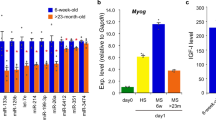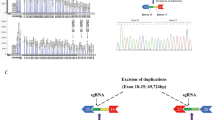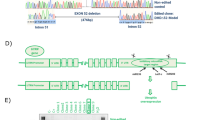Abstract
In patients with Duchenne muscular dystrophy (DMD), the absence of a functional dystrophin protein results in sarcolemmal instability, abnormal calcium signaling, cardiomyopathy, and skeletal muscle degeneration. Using the dystrophin-deficient sapje zebrafish model, we have identified microRNAs (miRNAs) that, in comparison to our previous findings in human DMD muscle biopsies, are uniquely dysregulated in dystrophic muscle across vertebrate species. MiR-199a-5p is dysregulated in dystrophin-deficient zebrafish, mdx5cv mice, and human muscle biopsies. MiR-199a-5p mature miRNA sequences are transcribed from stem loop precursor miRNAs that are found within the introns of the dynamin-2 and dynamin-3 loci. The miR-199a-2 stem loop precursor transcript that gives rise to the miR-199a-5p mature transcript was found to be elevated in human dystrophic muscle. The levels of expression of miR-199a-5p are regulated in a serum response factor (SRF)-dependent manner along with myocardin-related transcription factors. Inhibition of SRF-signaling reduces miR-199a-5p transcript levels during myogenic differentiation. Manipulation of miR-199a-5p expression in human primary myoblasts and myotubes resulted in dramatic changes in cellular size, proliferation, and differentiation. MiR-199a-5p targets several myogenic cell proliferation and differentiation regulatory factors within the WNT signaling pathway, including FZD4, JAG1, and WNT2. Overexpression of miR-199a-5p in the muscles of transgenic zebrafish resulted in abnormal myofiber disruption and sarcolemmal membrane detachment, pericardial edema, and lethality. Together, these studies identify miR-199a-5p as a potential regulator of myogenesis through suppression of WNT-signaling factors that act to balance myogenic cell proliferation and differentiation.
Similar content being viewed by others
Log in or create a free account to read this content
Gain free access to this article, as well as selected content from this journal and more on nature.com
or
Accession codes
Abbreviations
- cDNA:
-
complementary DNA
- ChIP:
-
chromatin immunoprecipitation
- DMD:
-
Duchenne muscular dystrophy
- DNM3OS:
-
dynamin-3 opposite strand
- Dox:
-
doxycycline
- EMSA:
-
electrophoretic mobility shift assay
- FACS:
-
fluorescence-activated cell sorting
- GFP:
-
green fluorescent protein
- HRP:
-
horse radish peroxidase
- IgG:
-
immunoglobulin G
- IRES:
-
internal ribosome entry site
- MB:
-
myoblasts
- miRNA:
-
microRNA
- MOI:
-
multiplicity of infection
- MRTF:
-
myocardin-related transcription factor
- MTS:
-
3-(4,5-dimethylthiazol-2-yl)-5-(3-carboxymethoxyphenyl)-2-(4-sulfophenyl)-2H-tetrazolium
- MSC:
-
muscle satellite cell
- MT:
-
myotubes
- mylz2:
-
myosin light chain polypeptide 2
- ORF:
-
open reading frame
- PBS:
-
phosphate-buffered saline
- qPCR:
-
quantitative PCR
- snRNA:
-
small nuclear RNA
- SRF:
-
serum response factor
- TA:
-
tibialis anterior
- TBS:
-
tris-buffered saline
- Tg:
-
transgenic
- YY1:
-
Yin-Yang 1
- WB:
-
western blot
- WNT:
-
wingless-type MMTV integration site family
- UTR:
-
untranslated region
References
Monaco AP, Neve RL, Colletti-Feener C, Bertelson CJ, Kurnit DM, Kunkel LM . Isolation of candidate cDNAs for portions of the Duchenne muscular dystrophy gene. Nature 1986; 323: 646–650.
Bakay M, Zhao P, Chen J, Hoffman EP . A web-accessible complete transcriptome of normal human and DMD muscle. Neuromuscul Disord 2002; 12 : Supplement S125–S141.
Haslett JN, Sanoudou D, Kho AT, Bennett RR, Greenberg SA, Kohane IS et al. Gene expression comparison of biopsies from Duchenne muscular dystrophy (DMD) and normal skeletal muscle. Proc Natl Acad Sci USA 2002; 99: 15000–15005.
Blau HM, Webster C, Pavlath GK . Defective myoblasts identified in Duchenne muscular dystrophy. Proc Natl Acad Sci 1983; 80: 4856–4860.
Polesskaya A, Seale P, Rudnicki MA . Wnt signaling induces the myogenic specification of resident CD45+ adult stem cells during muscle regeneration. Cell 2003; 113: 841–852.
Otto A, Schmidt C, Luke G, Allen S, Valasek P, Muntoni F et al. Canonical Wnt signalling induces satellite-cell proliferation during adult skeletal muscle regeneration. J Cell Sci 2008; 121: 2939–2950.
Le Grand F, Jones AE, Seale V, Scimè A, Rudnicki MA . Wnt7a activates the planar cell polarity pathway to drive the symmetric expansion of satellite stem cells. Cell Stem Cell 2009; 4: 535–547.
Brack AS, Conboy MJ, Roy S, Lee M, Kuo CJ, Keller C et al. Increased Wnt signaling during aging alters muscle stem cell fate and increases fibrosis. Science 2007; 317: 807–810.
Pescatori M, Broccolini A, Minetti C, Bertini E, Bruno C, D'amico A et al. Gene expression profiling in the early phases of DMD: a constant molecular signature characterizes DMD muscle from early postnatal life throughout disease progression. FASEB J 2007; 21: 1210–1226.
Alexander M, Casar JC, Motohashi N, Myers JA, Eisenberg I, Gonzalez RT et al. Regulation of DMD pathology by an ankyrin-encoded miRNA. Skeletal Muscle 2011; 1: 27.
Cacchiarelli D, Martone J, Girardi E, Cesana M, Incitti T, Morlando M et al. MicroRNAs involved in molecular circuitries relevant for the Duchenne Muscular Dystrophy pathogenesis are controlled by the dystrophin/nNOS pathway. Cell Metab 2010; 12: 341–351.
Eisenberg I, Eran A, Nishino I, Moggio M, Lamperti C, Amato AA et al. Distinctive patterns of microRNA expression in primary muscular disorders. Proc Natl Acad f Sci 2007; 104: 17016–17021.
van Rooij E, Quiat D, Johnson BA, Sutherland LB, Qi X, Richardson JA et al. A family of microRNAs encoded by myosin genes governs myosin expression and muscle performance. Dev Cell 2009; 17: 662–673.
van Rooij E, Sutherland LB, Qi X, Richardson JA, Hill J, Olson EN . Control of stress-dependent cardiac growth and gene expression by a microRNA. Science 2007; 316: 575–579.
Rao PK, Kumar RM, Farkhondeh M, Baskerville S, Lodish HF . Myogenic factors that regulate expression of muscle-specific microRNAs. Proc Natl Acad Sci 2006; 103: 8721–8726.
Bassett D, Currie PD . Identification of a zebrafish model of muscular dystrophy. Clin Exp Pharmacol Physiol 2004; 31: 537–540.
Kawahara G, Karpf JA, Myers JA, Alexander MS, Guyon JR, Kunkel LM . Drug screening in a zebrafish model of Duchenne muscular dystrophy. Proc Natl Acad Sci 2011; 108: 5331–5336.
Haslett J, Kang P, Han M, Kho AT, Sanoudou D, Volinski JM et al. The influence of muscle type and dystrophin deficiency on murine expression profiles. Mamm Genome 2005; 16: 739–748.
Roberts TC, Blomberg KEM, McClorey G, Andaloussi SE, Godfrey C, Betts C et al. Expression analysis in multiple muscle groups and serum reveals complexity in the microRNA transcriptome of the mdx mouse with implications for therapy. Mol Ther Nucleic Acids 2012; 1: e39.
Lee Y-B, Bantounas I, Lee D-Y, Phylactou L, Caldwell MA, Uney JB . Twist-1 regulates the miR-199a/214 cluster during development. Nucleic Acids Res 2009; 37: 123–128.
Sakurai K, Furukawa C, Haraguchi T, Inada K, Shiogama K, Tagawa T et al. MicroRNAs miR-199a-5p and -3p target the Brm subunit of SWI/SNF to generate a double-negative feedback loop in a variety of human cancers. Cancer Res 2011; 71: 1680–1689.
Gauthier-Rouviere C, Vandromme M, Tuil D, Lautredou N, Morris M, Soulez M et al. Expression and activity of serum response factor is required for expression of the muscle-determining factor MyoD in both dividing and differentiating mouse C2C12 myoblasts. Mol Biol Cell 1996; 7: 719–729.
Selvaraj A, Prywes R . Megakaryoblastic leukemia-1/2, a transcriptional co-activator of serum response factor, is required for skeletal myogenic differentiation. J Biol Chem 2003; 278: 41977–41987.
Soulez M, Rouviere CG, Chafey P, Hentzen D, Vandromme M, Lautredou N et al. Growth and differentiation of C2 myogenic cells are dependent on serum response factor. Mol Cell Biol 1996; 16: 6065–6074.
Guerci A, Lahoute C, Hébrard S, Collard L, Graindorge D, Favier M et al. Srf-dependent paracrine signals produced by myofibers control satellite cell-mediated skeletal muscle hypertrophy. Cell Metab 2012; 15: 25–37.
Mokalled MH, Johnson AN, Creemers EE, Olson EN . MASTR directs MyoD-dependent satellite cell differentiation during skeletal muscle regeneration. Genes Dev 2012; 26: 190–202.
Galvagni F, Lestingi M, Cartocci E, Oliviero S . Serum response factor and protein-mediated DNA bending contribute to transcription of the dystrophin muscle-specific promoter. Mol Cell Biol 1997; 17: 1731–1743.
Lu L, Zhou L, Chen EZ, Sun K, Jiang P, Wang L et al. A novel YY1-miR-1 regulatory circuit in skeletal myogenesis revealed by genome-wide prediction of YY1-miRNA network. PLoS ONE 2012; 7: e27596.
Jin W, Goldfine AB, Boes T, Henry RR, Ciaraldi TP, Kim EY et al. Increased SRF transcriptional activity in human and mouse skeletal muscle is a signature of insulin resistance. J Clin Invest 2011; 121: 918–929.
Ju B, Chong SW, He J, Wang X, Xu Y, Wan H et al. Recapitulation of fast skeletal muscle development in zebrafish by transgenic expression of GFP under the mylz2 promoter. Dev Dyn 2003; 227: 14–26.
He X, Yan Y-L, DeLaurier A, Postlethwait JH . Observation of miRNA gene expression in zebrafish embryos by in situ hybridization to microRNA primary transcripts. Zebrafish 2011; 8: 1–8.
Rane S, He M, Sayed D, Vashistha H, Malhotra A, Sadoshima J et al. Downregulation of miR-199a derepresses hypoxia-inducible factor-1α and Sirtuin 1 and recapitulates hypoxia preconditioning in cardiac myocytes. Circ Res 2009; 104: 879–886.
Kozopas KM, Nusse R . Direct flight muscles in Drosophila develop from cells with characteristics of founders and depend on DWnt-2 for their correct patterning. Dev Biol 2002; 243: 312–325.
Wang H, Gilner JB, Bautch VL, Wang DZ, Wainwright BJ, Kirby SL et al. Wnt2 coordinates the commitment of mesoderm to hematopoietic, endothelial, and cardiac lineages in embryoid bodies. J Biol Chem 2007; 282: 782–791.
Lindsell CE, Shawber CJ, Boulter J, Weinmaster G . Jagged: a mammalian ligand that activates notch1. Cell 1995; 80: 909–917.
Gnocchi VF, White RB, Ono Y, Ellis JA, Zammit PS . Further characterisation of the molecular signature of quiescent and activated mouse muscle satellite cells. PLoS ONE 2009; 4: e5205.
Molenaar M, van de Wetering M, Oosterwegel M, Peterson-Maduro J, Godsave S, Korinek V et al. XTcf-3 transcription factor mediates β-catenin-induced axis formation in xenopus embryos. Cell 1996; 86: 391–399.
Brannon M, Gomperts M, Sumoy L, Moon RT, Kimelman DA . β-catenin/XTcf-3 complex binds to thesiamois promoter to regulate dorsal axis specification in Xenopus. Genes Dev 1997; 11: 2359–2370.
Trompouki E, Bowman Teresa V, Lawton Lee N, Fan ZP, Wu DC, DiBiase A et al. Lineage regulators direct BMP and Wnt pathways to cell-specific programs during differentiation and regeneration. Cell 2011; 147: 577–589.
Cheung HH, Davis AJ, Lee TL, Pang AL, Nagrani S, Rennert OM et al. Methylation of an intronic region regulates miR-199a in testicular tumor malignancy. Oncogene 2011; 30: 3404–3415.
Lino Cardenas CL, Henaoui IS, Courcot E, Roderburg C, Cauffiez C, Aubert S et al. miR-199a-5p is upregulated during fibrogenic response to tissue injury and mediates TGFbeta-induced lung fibroblast activation by targeting caveolin-1. PLoS Genet 2013; 9: e1003291.
Song X-W, Li Q, Lin L, Wang XC, Li DF, Wang GK et al. MicroRNAs are dynamically regulated in hypertrophic hearts, and miR-199a is essential for the maintenance of cell size in cardiomyocytes. J Cell Physiol 2010; 225: 437–443.
Sander M, Chavoshan B, Harris SA, Iannaccone ST, Stull JT, Thomas GD et al. Functional muscle ischemia in neuronal nitric oxide synthase-deficient skeletal muscle of children with Duchenne muscular dystrophy. Proc Natl Acad Sci 2000; 97: 13818–13823.
Zhao Y, Samal E, Srivastava D . Serum response factor regulates a muscle-specific microRNA that targets Hand2 during cardiogenesis. Nature 2005; 436: 214–220.
Liu N, Williams AH, Kim Y, McAnally J, Bezprozvannaya S, Sutherland LB et al. An intragenic MEF2-dependent enhancer directs muscle-specific expression of microRNAs 1 and 133. Proc Natl Acad Sci 2007; 104: 20844–20849.
Xin M, Small EM, Sutherland LB, Qi X, McAnally J, Plato CF et al. MicroRNAs miR-143 and miR-145 modulate cytoskeletal dynamics and responsiveness of smooth muscle cells to injury. Genes Dev 2009; 23: 2166–2178.
Small EM, O'Rourke JR, Moresi V, Sutherland LB, McAnally J, Gerard RD et al. Regulation of PI3-kinase/Akt signaling by muscle-enriched microRNA-486. Proc Natl Acad Sci 2010; 107: 4218–4223.
Zhang X, Azhar G, Helms S, Wei J . Regulation of cardiac microRNAs by serum response factor. J Biomed Sci 2011; 18: 15.
Motohashi N, Alexander MS, Casar JC, Kunkel LM . Identification of a novel microRNA that regulates the proliferation and differentiation in muscle side population cells. Stem Cells Dev 2012; 21: 3031–3043.
Cheung TH, Quach NL, Charville GW, Liu L, Park L, Edalati A et al. Maintenance of muscle stem-cell quiescence by microRNA-489. Nature 2012; 482: 524–528.
Goupille O, Pallafacchina G, Relaix F, Conway SJ, Cumano A, Robert B et al. Characterization of Pax3-expressing cells from adult blood vessels. J Cell Sci 2011; 124: 3980–3988.
L'Honore A, Lamb NJ, Vandromme M, Turowski P, Carnac G, Fernandez A . MyoD distal regulatory region contains an SRF binding CArG element required for MyoD expression in skeletal myoblasts and during muscle regeneration. Mol Biol Cell 2003; 14: 2151–2162.
von Maltzahn J, Bentzinger CF, Rudnicki MA . Wnt7a-Fzd7 signalling directly activates the Akt/mTOR anabolic growth pathway in skeletal muscle. Nat Cell Biol 14: 186–191.
Guyon JR, Goswami J, Jun SJ, Thorne M, Howell M, Pusack T et al. Genetic isolation and characterization of a splicing mutant of zebrafish dystrophin. Human Mol Genet 2009; 18: 202–211.
Langenau DM, Keefe MD, Storer NY, Guyon JR, Kutok JL, Le X et al. Effects of RAS on the genesis of embryonal rhabdomyosarcoma. Genes Dev 2007; 21: 1382–1395.
Lawrence C, Best J, James A, Maloney K . The effects of feeding frequency on growth and reproduction in zebrafish (Danio rerio). Aquaculture 2012; 368-369: 103–108.
Stadtfeld M, Maherali N, Breault DT, Hochedlinger K . Defining molecular cornerstones during fibroblast to iPS cell reprogramming in mouse. Cell Stem Cell 2008; 2: 230–240.
Muehlich S, Wang R, Lee S-M, Lewis TC, Dai C, Prywes R . Serum-induced phosphorylation of the serum response factor coactivator MKL1 by the extracellular signal-regulated kinase 1/2 pathway inhibits its nuclear localization. Mol Cell Biol 2008; 28: 6302–6313.
Dorsky RI, Sheldahl LC, Moon RTA . Transgenic Lef1/β-catenin-dependent reporter is expressed in spatially restricted domains throughout zebrafish development. Dev Biol 2002; 241: 229–237.
Acknowledgements
Funding for this work was generously provided by the Bernard F. and Alva B. Gimbel Foundation (LMK) and through a NIH grant (P50 NS040828-10). MSA was funded by a traineeship awarded by the NIH through the Harvard Stem Cell Institute and supported by a Muscular Dystrophy Association (MDA) Development Grant MDA255059. PBK is supported by the Muscular Dystrophy Association (MDA186796 and MDA 114353) and the Genise Goldenson Fund. ATK is supported by an NIH grant HL091124. The F59 (developed by F.E. Stockdale), MF20 (developed by D.A. Fischman), and Pax7 (developed by A. Kawakami) antibodies were obtained from the Developmental Studies Hybridoma Bank (DSHB) developed under the auspices of the NICHD and maintained by The University of Iowa, Department of Biology, Iowa City, IA, USA. We thank Louise Trakimas for assistance with the electron microscopy and Christoph Eicken at LC Sciences LLC for assistance with the microarray data analysis and processing. Flow cytometry was performed in the IDDRC Stem Cell Core Facility at Boston Children’s Hospital that is supported by National Institutes of Health award NIH-P30-HD18655. We thank Emanuela Gussoni for a critical reading of the manuscriptOur thanks to Teresa Bowman for sharing zebrafish WNT signaling primer sequences and Bryan MacDonald for helpful discussions about the WNT signaling pathway. We thank Dr. Morris White and Dr. Kyle Copps for our usage of imaging equipment. We also thank all the families and patients who donated their biopsies and time for these experiments.
Author contributions
MSA designed and performed the experiments and analyzed the data. JCC, NM, JAM, MJG, SM, and GK performed the experiments and helped in the analysis of the data. IE performed the experiments and contributed new reagents. ATK analyzed the microRNA microarray data. EAE collected patient samples, family histories, and reagents. FS isolated muscle biopsies from normal and DMD patients. PBK contributed new reagents and edited the manuscript. MSA and L.M.K. analyzed all of the data and wrote the manuscript. All authors have read and approved of the manuscript before submission.
Author information
Authors and Affiliations
Corresponding author
Ethics declarations
Competing interests
LMK is a consultant for Pfizer Inc. for muscle disease drug therapies. The remaining authors declare no conflict of interest.
Additional information
Edited by RA Knight
Supplementary Information accompanies this paper on Cell Death and Differentiation website
Rights and permissions
About this article
Cite this article
Alexander, M., Kawahara, G., Motohashi, N. et al. MicroRNA-199a is induced in dystrophic muscle and affects WNT signaling, cell proliferation, and myogenic differentiation. Cell Death Differ 20, 1194–1208 (2013). https://doi.org/10.1038/cdd.2013.62
Received:
Revised:
Accepted:
Published:
Issue date:
DOI: https://doi.org/10.1038/cdd.2013.62
Keywords
This article is cited by
-
Hypoxia treatment and resistance training alters microRNA profiling in rats skeletal muscle
Scientific Reports (2024)
-
Differential histological features and myogenic protein levels in distinct muscles of d-sarcoglycan null muscular dystrophy mouse model
Journal of Molecular Histology (2023)
-
MiRNA sequencing of Embryonic Myogenesis in Chengkou Mountain Chicken
BMC Genomics (2022)
-
Wnt/β-catenin signalling: function, biological mechanisms, and therapeutic opportunities
Signal Transduction and Targeted Therapy (2022)
-
MicroRNA-503-3p affects osteogenic differentiation of human adipose-derived stem cells by regulation of Wnt2 and Wnt7b under cyclic strain
Stem Cell Research & Therapy (2020)



